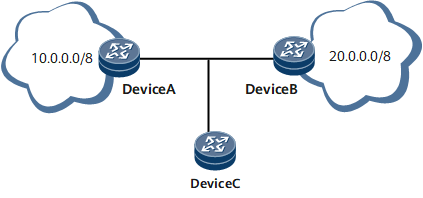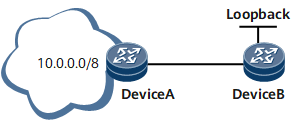Split Horizon
Split Horizon on Broadcast, P2PMP, and P2P Networks
Split horizon prevents a RIP-enabled interface from sending back the routes it learns, which reduces bandwidth consumption and prevents routing loops.
- A direct route with zero hops
- A route with Device B as the next hop and total two hops
If the route from Device A to 10.0.0.0/8 becomes unreachable and Device B is not notified, Device B still considers the route to 10.0.0.0/8 reachable and continues sending this route to Device A. Then, Device A receives incorrect routing information and considers the route to 10.0.0.0/8 reachable through Device B; Device B considers the route to 10.0.0.0/8 reachable through Device A. As a result, a loop occurs on the network.
After split horizon is configured, Router B no longer sends the route back after learning the route, which prevents such a loop.
Split Horizon on NBMA Networks
On a Non-Broadcast Multi-Access (NBMA) network where an interface is connected to multiple neighbors, RIP supports neighbor-based split horizon. On NBMA networks, routes are sent in unicast mode, and an interface can differentiate which neighbor each route was learned from, and the interface will not send the routes back to the neighbor it learned them from.

In Figure 2, Device A sends the route to 10.0.0.0/8 that it learns from Device B only to Device C.
